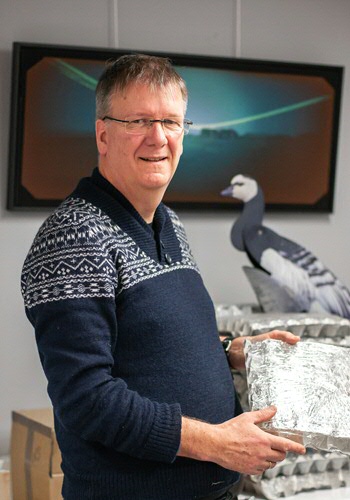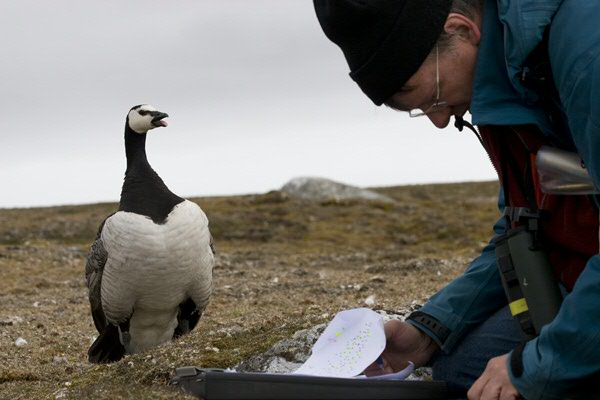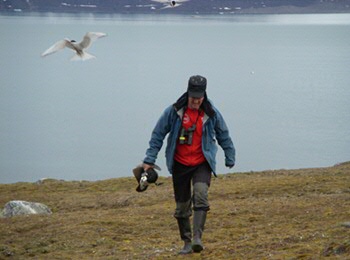Maarten Loonen’s climate change grief

For many years now, Maarten Loonen has seen first-hand how the climate has changed on Spitsbergen. He can talk for hours about geese, reindeer, glaciers and the immeasurable, still undiscovered nature on the Norwegian island. His main concern, though, is the ticking of the climate clock.
Text: Eelco Salverda, Communication UG
His room looks like a private museum. Two boots sporting a sticker: ‘transport, M. Loonen’, three papier maché Arctic terns on the ceiling, piles of egg boxes filled with teabags, a home-made penguin on two large freezers. Two freezers? Loonen opens them: three dead geese wrapped in plastic, blood samples for immune system research. ‘Yes, I keep everything here that we’ve ever collected. A proper storage system would be nice,’ he says, laughing apologetically.

Teabags in the wilderness
The teabags are part of a worldwide study into the decomposition of plant material. They’ve spent a year in the Spitsbergen earth. Maarten Loonen has been visiting the Ny Ålesund research village in Spitsbergen for thirty years now, researching various subjects, including geese. He remembers what struck him most on his first visit. ‘The mind-blowing wilderness. The fjord near the village – the mouth of six glaciers. A nature that is beyond our knowledge. Did you know that the polar bear is the only animal apart from the tiger that regards humans as prey? They can creep up on you silently without you noticing. Or it seems as though they’re interested in something else, and then, when they’re close enough, they’ll suddenly charge at you. If that happens, you don’t stand a chance.’ As an ecologist, he tries to decipher what we’re seeing around us. That’s quite a challenge on Spitsbergen. ‘This place is unfathomable. The nature has a layeredness beyond our scope of knowledge; you keep discovering things.’ Loonen was to discover many things in recent years which didn’t make him happy.
The new normal
A conversation with Loonen soon turns to climate change and its consequences. ‘All the glaciers have shrunk by about three kilometres. When I visit now, I see mountains and sail past islands that always used to be covered in ice. Not so very long ago, you would hear a thunderous sound in the village whenever a chunk of a glacier fell off into the sea. Now, there is silence.’ During our conversation, Loonen frequently bends over his computer to show statistics and graphs. Temperature, ice quantities, a map showing Spitsbergen as a dark red mark in the Arctic region. ‘Here, you can see that the temperature on Spitsbergen is rising much more quickly than elsewhere. I’m obsessed with these graphs. I look at them all day. The worst thing, in my opinion, is that we can hardly imagine what it used to be like. Climate statistics often show an average over the past 30 years, but that camouflages part of the warming effect, shifting your reference framework.’

Open fjord
Initially, Loonen was not overly concerned about climate change. ‘In 1990, a glaciologist told me that Spitsbergen wouldn’t be too badly affected. I think some politicians were on the ball before I was,’ he jokes. His vision changed in 2006. ‘For the first time in the existence of Ny Ålesund – since 1917 – the fjord hadn’t frozen over.’ A single incident became a permanent feature: the fjord has never again frozen over. And that’s not the only change Loonen has seen. Geese came to breed earlier in the year, and polar bears turned up in the village looking for food. Glaciers crumbled, and ringed seals disappeared, making way for common seals. The number of weeks when the temperature remained above zero increased by a third, on average. ‘There had always been small changes, but ten years ago, the changes suddenly became seismic. Now, the temperature is sometimes above freezing even in the winter. And then there are heavy rains, followed by freezing. That has a massive impact on the tundra and the life there. Reindeer cannot access food because of the frozen rain. On Spitsbergen, there are houses that have become uninhabitable due to landslides, and new buildings have to be shored up. Imagine that your house is no longer safe. Apart from war and disease, that’s about the worst thing that can happen to anyone.’
Silent killer
As a researcher, Loonen had always worked with models and forecasts. That doesn’t work anymore, he says. ‘You don’t know what direction things are going in now. Global warming doesn’t mean we’ll be getting a pleasant French summer here. It means unpredictability.’ Can’t he view the developments with some kind of scientific curiosity? ‘No, not any more,’ he says with conviction. ‘It’s fear. The thought that what I’m seeing there can happen here, too. That things happen very slowly at first, and then irreversibly fast.’ The image of the polar bear comes to mind – lulling you to sleep, biding its time, and then attacking. Climate as a silent killer.
Panic
Loonen’s face reddens, tears well up in the corners of his eyes. This happens again later on in the conversation, when he talks about the damage to the Great Barrier Reef and the words of Ban Ki Moon, honorary doctor of the University of Groningen: ‘We are the last generation that can end climate change’. He continues, almost bitterly: ‘We used to speak of the consequences for our grandchildren. Now we’re going to experience it ourselves. There have been warnings for fifteen years, but we have made no progress at all.’ He apologises for the tearfulness. Why is he so sensitive? Is he sometimes accused of appealing to emotion? ‘No, it makes an impression, and luckily, it has an effect. But I would like it to stop. I would rather convince with facts than with feelings. I was determined to stay dry-eyed for this conversation, but I sometimes get overwhelmed by panic when I talk about these things.’ Loonen has become a man of experience rather than models. He wants to be a witness. He says, ‘I’m a farmer and a teacher. A farmer because I love animals and have a broad interest in the nature around me, and a teacher because I want to convey a message.’
Working on Ny Ålesund
Conducting research on Spitsbergen is no easy matter. The cunning hunting tactics of the polar bear is one reason Loonen and his colleagues are always well-prepared when they leave the village to do fieldwork. Take a shooting course, follow safety instructions, never go out alone. Always have a gun with you, binoculars and a radio. ‘Ny Ålesund is a research village, owned by a company. There are a hundred and thirty people there during the summer, and thirty in the winter. You hire a place to stay, and the company takes care of food, waste disposal, logistics and infrastructure.‘ Researchers from the University of Groningen have been manning two cabins for decades. This is funded by the Ministry of Foreign Affairs, because the presence of researchers is also geopolitically important. He laughs, ‘I’ve been called the Netherlands’ cheapest ambassador.’

Thirty years travelling to and fro
Thirty years away from home from mid-June to mid-August. What is that like? ‘The first five years were amazing. After that, you start to realise that you are missing things at home. Summer in the Netherlands, your family. I couldn’t stay away for more than two months. And some of the awe has worn off after all those years. A while ago, some students shouted that they’d spotted a whale. I said ‘Hurry, go and look’, but stayed inside myself. I’d missed a sighting of a rare Greenland whale!’
Heralding the summer
Has Loonen ever considering going during the winter? ‘No, I’m an outdoor person, a field biologist. Nature shuts down during the winter. I want to see nature in her full glory! My work there is an inextricable part of my identity. I always look forward to going there. I’ve even come to belong there. When I arrive, the permanent residents know that summer has come.’ Loonen, the swallow that heralds summer. And that’s about the best news that Spitsbergen can expect for the foreseeable future...
- In Focus: Maarten Loonen
- On 14 February at 5.35 p.m., Arte will broadcast a documentary featuring Loonen, his students and his research. The documentary shows what it’s like to work and live in Ny-Ålesund and is part of the series Habiter le monde.
More news
-
11 December 2025
Stormy planets and an unexpected atmosphere
-
09 December 2025
University of Groningen Professor at COP30: ‘There is always drama’
